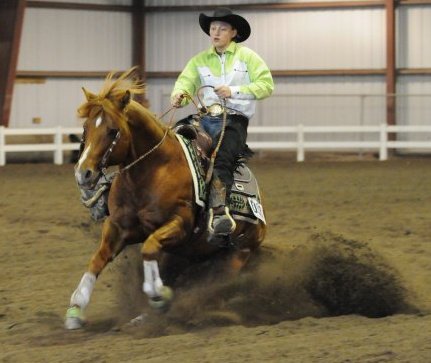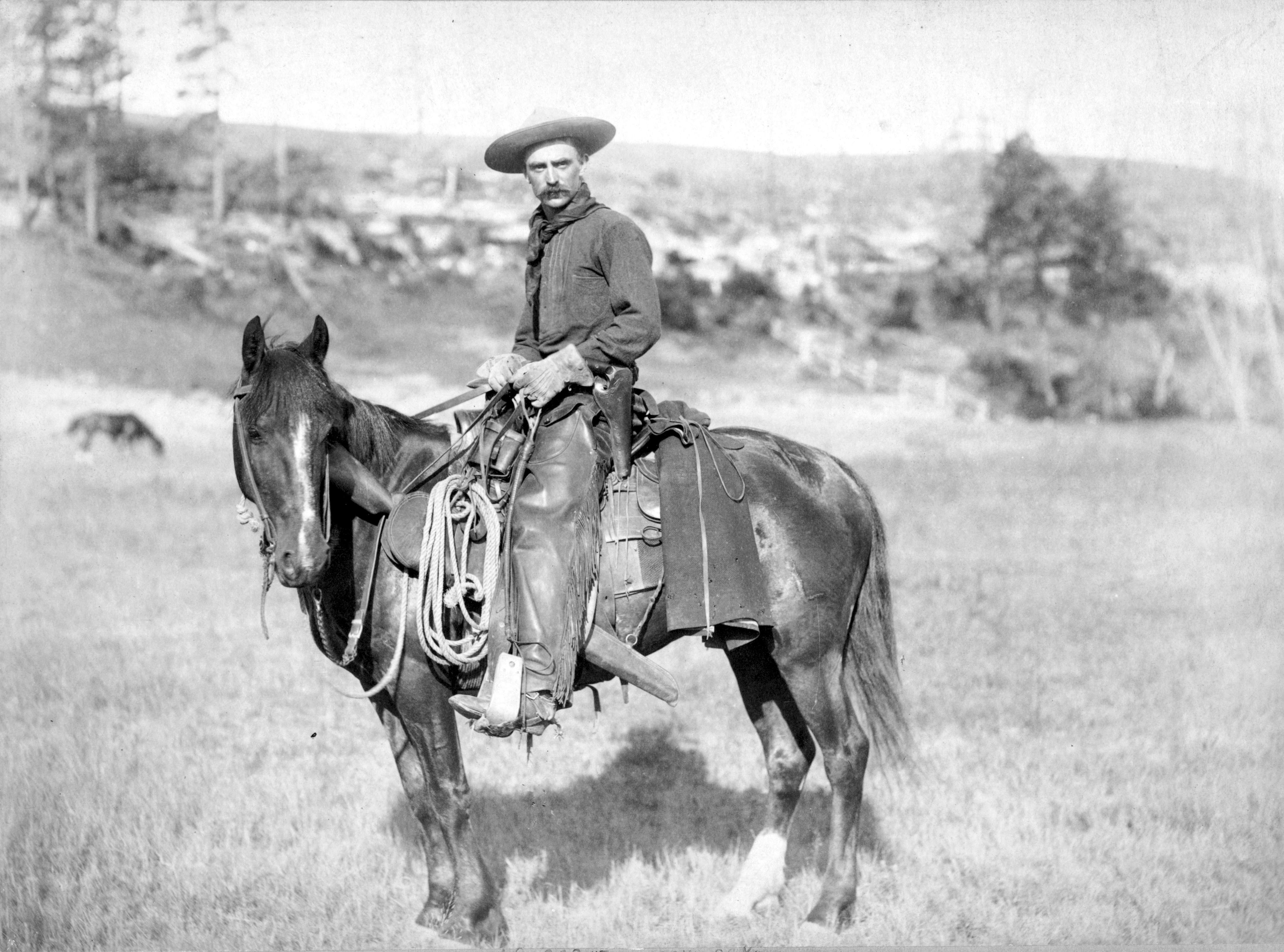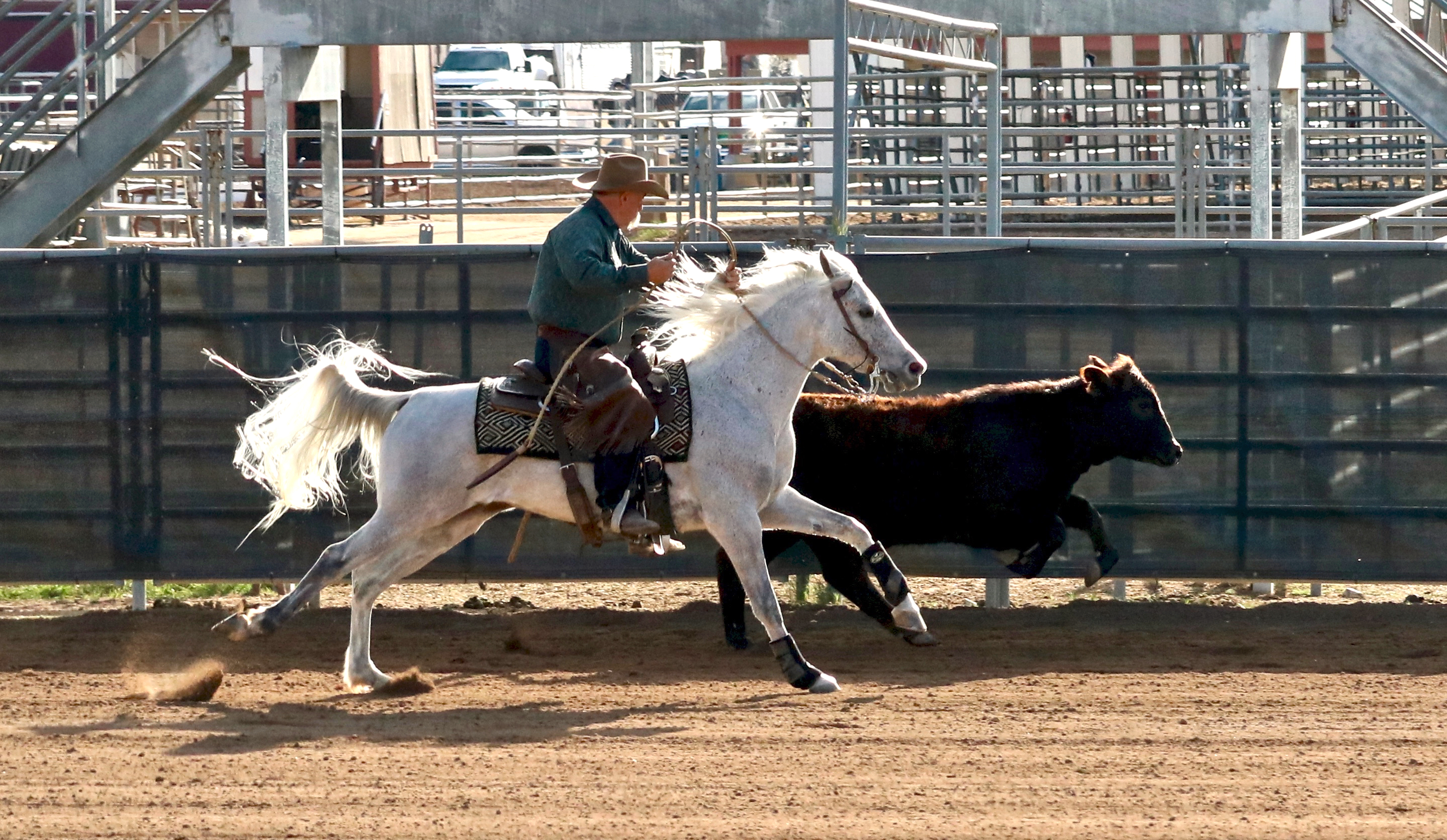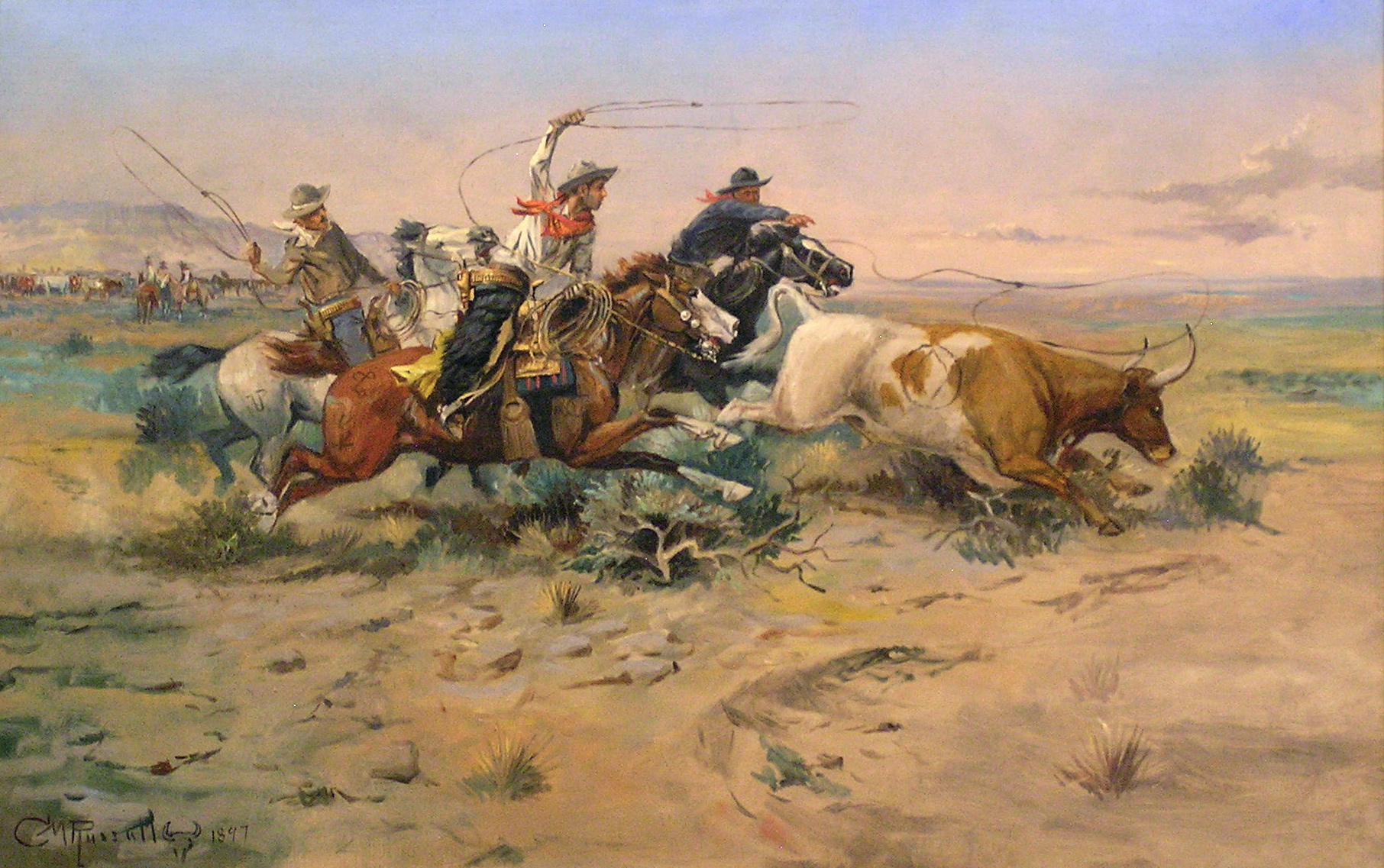|
Reining
Reining is a western riding competition for horses in which the riders guide the horses through a precise pattern of circles, spins, and stops. All work is done at the lope (a version of the horse gait more commonly known worldwide as the canter), or the gallop (the fastest of the horse gaits). Originating from working cattle, reining requires the horse to be responsive and in tune with its rider, whose aids should not be easily seen, and judges the horse on its ability to perform a set pattern of movements. The horse should be willingly guided or controlled with little or no apparent resistance and dictated to completely. A horse that pins his ears, conveys a threat to his rider, refuses to go forward, runs sideways, bounces his rear, wrings his tail in irritation, or displays an overall poor attitude is not being guided willingly, and is judged accordingly. If a horse jogs or breaks gait it is a 0. Origins Throughout the history of the Americas, dating back to the earliest S ... [...More Info...] [...Related Items...] OR: [Wikipedia] [Google] [Baidu] [Amazon] |
Western Riding
Western riding is considered a style of horse riding which has evolved from the ranching and welfare traditions which were brought to the Americas by the Spanish conquistadors, as well as both equipment and riding style which evolved to meet the working needs of the cowboy in the American West. At the time, American cowboys had to work long hours in the saddle and often over rough terrain, sometimes having to rope a cattle using a lariat, also known as a lasso. Because of the necessity to control the horse with one hand and use a lariat with the other, western horses were trained to neck rein, that is, to change direction with light pressure of a rein against the horse's neck. Horses were also trained to exercise a certain degree of independence in using their natural instincts to follow the movements of a cow, thus a riding style developed that emphasized a deep, secure seat, and training methods encouraged a horse to be responsive on very light rein contact. There are signific ... [...More Info...] [...Related Items...] OR: [Wikipedia] [Google] [Baidu] [Amazon] |
Working Cow Horse
Working cow horse or reined cow horse is a type of Western riding competition in which horse and rider are tested for ability to work cattle. It is organised by the National Reined Cow Horse Association in North America, and by the European Reined Cow Horse Association in Europe. Horses are judged on accuracy, timing, and responsiveness. Competition Reined cow horse events which are "open" to all breeds and held by the National Reined Cow Horse Association (NRCHA). Working cow horse events are also held at breed specific shows, such as at an American Quarter Horse AssociationAQHA Show Classes accessed on October 31, 2007 or Arabian Horse Association show,Andrew "Looking for an Adr ... [...More Info...] [...Related Items...] OR: [Wikipedia] [Google] [Baidu] [Amazon] |
Flying Change
Lead refers to which set of legs, left or right, leads or advances forward to a greater extent when a quadruped animal is canter and gallop, cantering, galloping, or jumping (horse), leaping. The feet on the leading side touch the ground forward of its partner. On the "left lead", the animal's left legs lead. The choice of lead is of special interest in equestrianism, horse riding. A lead change refers to an animal, usually a horse, moving in a canter or Horse gait#Gallop, gallop, changing from one lead to the other. There are two basic forms of lead change: simple and flying. It is very easy to define the correct lead from the incorrect lead. When a horse is executing the correct lead, the inside front and hind legs reach farther forward than the outside legs. In a transverse or lateral or united canter and gallop, the hind leg on the same side as the leading foreleg (the lateral hindleg) advances more.Tristan David Martin Roberts (1995) ''Understanding Balance: The Mecha ... [...More Info...] [...Related Items...] OR: [Wikipedia] [Google] [Baidu] [Amazon] |
International Federation For Equestrian Sports
The International Federation for Equestrian Sports (, FEI) is the international sport governing body, governing body of equestrianism, equestrian sports. The FEI came into being following the Olympic Congress in Lausanne (SUI) in 1921 from May 28 to May 30. It's headquarters are in Lausanne, Switzerland. The FEI is responsible for drafting and enforcing regulations within the six disciplines under its jurisdiction. Besides regulation, overseeing all international competitions and Championships, overseeing and cooperating with all affiliated national federations, overseeing and educating officials and registering riders and horses are core tasks of the FEI. As an umbrella equestrian organisation, the FEI focuses on promoting equestrian sport, attracting and cooperating with sponsors, media and fans, and representing equestrian sport on various online and offline channels. An FEI code of conduct protects the welfare of the horses from animal cruelty, physical abuse or doping. On ... [...More Info...] [...Related Items...] OR: [Wikipedia] [Google] [Baidu] [Amazon] |
Western Saddle
Western saddles are used for Western riding and are the saddles used on working horses on cattle ranches throughout the United States, particularly in the west. They are the "cowboy" saddles familiar to movie viewers, rodeo fans, and those who have gone on trail rides at guest ranches. This saddle was designed to provide security and comfort to the rider when spending long hours on a horse, traveling over rugged terrain. The design of the Western saddle derives from the saddles of the Mexican ''vaqueros''—the early horse trainers and cattle handlers of Mexico and the American Southwest. It was developed for the purpose of working cattle across vast areas, and came from a combination of the saddles used in the two main styles of horseback riding then practiced in Spain—'' la jineta'', the Moorish style which allowed great freedom of movement to the horse; and ''la estradiota'' (later known as la brida), a jousting style, which provided great security to the rider and strong ... [...More Info...] [...Related Items...] OR: [Wikipedia] [Google] [Baidu] [Amazon] |
Horse Show
A horse show is a judged exhibition of horses and pony, ponies. Many different horse breeds and equestrianism, equestrian disciplines hold competitions worldwide, from local to the international levels. Most horse shows run from one to three days, sometimes longer for major, all-breed events or national and international championships. Most shows consist of a series of different performances, called ''classes'', wherein a group of horses with similar training or characteristics compete against one another for awards and, often, prize money. International organizations and competitions There are several international disciplines run under rules established by the ''International Federation for Equestrian Sports, Fédération équestre internationale'' (FEI): *Combined driving *Dressage *Endurance riding *Eventing *Para-equestrian *Reining *Show jumping *Horse showmanship, Showmanship *Tent pegging *equestrian vaulting, Vaulting *Western Pleasure The rules of the FEI govern com ... [...More Info...] [...Related Items...] OR: [Wikipedia] [Google] [Baidu] [Amazon] |
Canter
The canter and gallop are variations on the fastest gait that can be performed by a horse or other equine. The canter is a controlled three-beat gait, while the gallop is a faster, four-beat variation of the same gait. It is a natural gait possessed by all horses, faster than most horses' trot, or ambling gaits. The gallop is the fastest gait of the horse, averaging about . The speed of the canter varies between depending on the length of the horse's stride. A variation of the canter, seen in western riding, is called a lope, and is generally quite slow, no more than . Etymology Since the earliest dictionaries there has been a commonly agreed suggestion that the origin of the word "canter" comes from the English city of Canterbury, a place of pilgrimage in the Middle Ages, as referred to in ''The Canterbury Tales'', where the comfortable speed for a pilgrim travelling some distance on horseback was above that of a trot but below that of a gallop. However, a lack of compell ... [...More Info...] [...Related Items...] OR: [Wikipedia] [Google] [Baidu] [Amazon] |
Cowboy
A cowboy is an animal herder who tends cattle on ranches in North America, traditionally on horseback, and often performs a multitude of other ranch-related tasks. The historic American cowboy of the late 19th century arose from the ''vaquero'' traditions of northern Mexico and became a figure of special significance and legend.Malone, J., p. 1. A subtype, called a Wrangler (profession), wrangler, specifically tends the horses used to work cattle. In addition to ranch work, some cowboys work for or participate in rodeos. Cowgirls, first defined as such in the late 19th century, had a less-well documented historical role, but in the modern world work at identical tasks and have obtained considerable respect for their achievements. Cattle handlers in many other parts of the world, particularly South America and Australia, perform work similar to the cowboy. The cowboy has deep historic roots tracing back to Spain and the earliest European Settlement of the Americas, settlers of th ... [...More Info...] [...Related Items...] OR: [Wikipedia] [Google] [Baidu] [Amazon] |
Cutting (sport)
Cutting is a western-style equestrian competition in which a horse and rider work together before a judge or panel of judges to demonstrate the horse's athleticism and ability to handle cattle. Modern competition utilizes a minute performance, called a "run." Each contestant is assisted by four helpers: two are designated as turnback riders, who help to keep cattle from running off to the back of the arena, the other two are designated as herd holders to keep the cattle bunched together and prevent potential strays from escaping into the work area. Cutting cattle are typically young steers and heifers that customarily range in size from . They usually are of Angus or Hereford lineage though may be a mix of crossbred beef cattle, including Charolais Braford or Brahman lineage. A contestant is required to make at least two cuts from the herd, one of which must be a cut from deep inside the herd while the other(s) can be peeled from the edges. Once the selected cow has been ... [...More Info...] [...Related Items...] OR: [Wikipedia] [Google] [Baidu] [Amazon] |
Reinback
"Rein-back" is a dressage term to indicate the two-beat movement in which a horse is asked to back up. The horse picks up and sets down its feet almost in diagonal pairs, and moves straight backwards with the line of his forelegs following those of his hind. The horse should remain on the aids during the rein-back. The rein-back should be practiced sparingly, as it can easily over-stress the horse's back and joints. This is especially true if the rider tries to force the horse into the movement. Asking for the rein-back To perform the rein-back, the rider applies both leg aids and a resisting hand. The leg asks the horse to move, but the hand prevents the horse from going forward, so it instead releases that energy in a step back. As soon as the horse begins to step back, the aids are released. The rein-back should be performed in a straight line, with the rider's legs used softly behind the girth to keep the hindquarters straight. The upper body of the rider stays upright, lean ... [...More Info...] [...Related Items...] OR: [Wikipedia] [Google] [Baidu] [Amazon] |
Horse Gait
Horses can use various gaits (patterns of leg movement) during Terrestrial locomotion, locomotion across solid ground, either naturally or as a result of specialized horse training, training by humans.Ensminger, M. E. ''Horses and Horsemanship'' 6th edition USA: Interstate Publishers 1990 pp. 65–66 Classification Gait, Gaits are typically categorized into two groups: the "natural" gaits that most horses will use without special training, and the "Ambling gait, ambling" gaits that are various smooth-riding, four-beat footfall patterns that may appear naturally in some individuals. Special training is often required before a horse will perform an ambling gait in response to a equestrianism, rider's command. Another system of classification that applies to Quadrupedalism, quadrupeds uses three categories: walking and ambling gaits, running or trotting gaits, and leaping gaits.Tristan David Martin Roberts (1995) ''Understanding Balance: The Mechanics of Posture and Locomotion'', ... [...More Info...] [...Related Items...] OR: [Wikipedia] [Google] [Baidu] [Amazon] |
Horse Tack
Tack is equipment or accessories equipped on horses and other equines in the course of their use as domestication of the horse, domesticated animals. This equipment includes such items as Saddle, saddles, Stirrup, stirrups, Bridle, bridles, Halter, halters, Rein, reins, Bit (horse), bits, and harnesses. Equipping a horse is often referred to as tacking up, and involves putting the tack equipment on the horse. A room to store such equipment, usually near or in a stable, is a tack room. Saddles Saddles are seats for the horseback riding, rider, fastened to the horse's Back (horse), back by means of a ''Girth (tack), girth'' in English-style riding, or a ''cinch'' in the use of Western tack. Girths are generally a wide strap that goes around the horse at a point about four inches behind the forelegs. Some western saddles will also have a second strap known as a ''flank'' or ''back cinch'' that fastens at the rear of the saddle and goes around the widest part of the horse's belly. ... [...More Info...] [...Related Items...] OR: [Wikipedia] [Google] [Baidu] [Amazon] |








